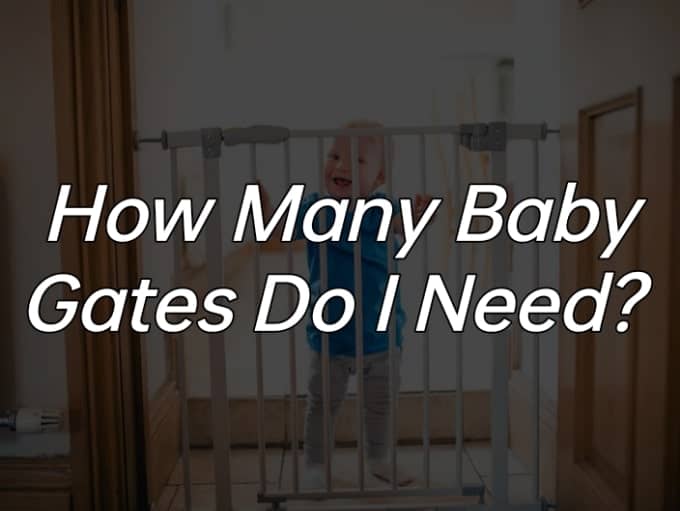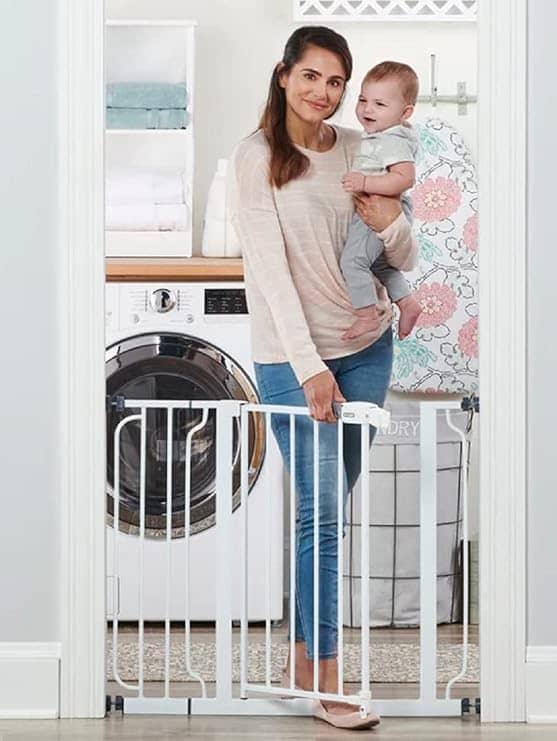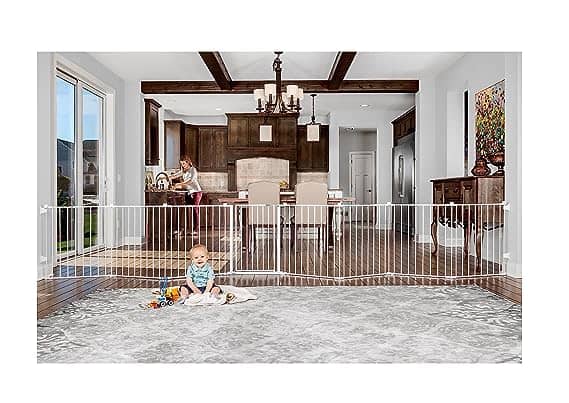Table of Contents
ToggleDeciding on how many baby gates do you need? can seem like a puzzling task for new parents. Ensuring your little one’s safety while maintaining the functionality of your home is a delicate balance.
Let’s unravel this mystery together and delve into the details of the number of baby gates required in your home.
How many baby gates do you need?
The number of baby gates you need largely depends on the layout of your home and the areas where your child spends most of their time.
Typically, parents should consider installing baby gates at the top and bottom of stairs, in doorways of rooms with potential hazards (like the kitchen or bathroom), and around fireplaces or other dangerous areas.
However, every home is unique, so consider your space carefully. A walk-through of your home to identify potential danger zones can be invaluable in determining the number of gates needed.
What to Consider When Deciding How Many Baby Gates You Need?
Considerations for Deciding the Number of Baby Gates
- Your Child’s Age and Mobility: Younger children who are just starting to crawl or toddlers who have started walking require more stringent safety measures. They’re more likely to explore and may not understand dangers, making baby gates more necessary.
- Home Layout: As already mentioned, the layout of your home significantly influences the number of baby gates. If you have multiple hazardous areas or multiple levels, you’ll need more gates.
- Lifestyle: If you often bring your child to different areas of the home, or if you have an open-concept house, you may need more gates to create safe play zones.
- Babysitter or Grandparents: If your child spends a lot of time with caregivers who might find it difficult to continuously supervise, like grandparents, additional gates may provide essential safety buffers.
- Pets: If you have pets, you may want to consider extra gates to separate them from the baby’s play area.
Remember, the primary purpose of baby gates is to prevent accidents and provide a safe environment for your child to grow and explore.
Estimating the Number of Baby Gates You Need:
Although it’s difficult to provide a definitive number due to the variability among homes and lifestyles, here’s an approximate guide to help you estimate the number of baby gates you might need:
- Staircases: Count the number of staircases in your home. You’ll typically need two gates per staircase (one at the top and one at the bottom), so double this number.
- Hazardous Rooms: Count the rooms with potential hazards such as kitchens, bathrooms, or rooms with fireplaces. Each of these will need a gate.
- Open-Concept Areas: Open spaces can be tricky, but if there are areas within these spaces that can be cordoned off, consider these as extra places needing a gate.
- Frequent Activity Spaces: Consider the number of rooms in which your child spends a lot of time. Each of these may need a gate for when you’re not able to provide full supervision.
- Pets: If you have pets, consider setting up a separate space for them away from your child’s play area.
Total Estimate:
Location
Staircases (top and bottom):
Hazardous Rooms:
Open-Concept Areas:
Frequent Activity Spaces :
Pets:
Total Gates Required:
Number
Number of staircases x 2.
Number of hazardous rooms.
Number of open-concept areas.
Number of frequent activity spaces.
Number of pet areas.
Sum of all above.
Remember, this is just an estimation guide.
Consider consulting with a child safety expert for a more accurate assessment based on your circumstances.
Where to Place Your Baby Gates for Maximum Safety?
Once you’ve determined how many baby gates you need, the next step is deciding where to place them for maximum child safety. Here are common areas where baby gates are usually installed:
- Staircases: Staircases are the most common and critical places for baby gates. Gates should be installed at both the top and the bottom of staircases. At the top, a gate prevents your child from accidentally falling down the stairs, while at the bottom, it stops them from climbing up and potentially falling.
- Kitchens and Bathrooms: These rooms pose numerous hazards to young children, such as hot surfaces, sharp objects, chemicals, and the risk of drowning. A baby gate can restrict access to these areas.
- Fireplaces, Heaters, and Stoves: These pose a burn risk, especially during the colder months when they are more likely to be in use. A baby gate can keep a safe distance between your child and these hazards.
- Open-Concept Areas: In open living spaces, it can be challenging to keep track of a mobile child. Baby gates can create safe zones, limiting your child’s range and making it easier to supervise their activities.
- Room with Fragile Items: If you have rooms with delicate objects, such as a home office with electronics or a living room with a large TV, a baby gate can prevent your child from accessing and potentially damaging these items.
- Outdoor Areas: Gardens and patios can also have multiple hazards for a child, from plants to gardening tools. A baby gate at the door leading to these areas can prevent unsupervised excursions.
Remember, the placement of baby gates can change as your child grows and their range of motion expands. Always keep reassessing your home’s safety as your child develops.
Choosing the Right Type of Baby Gate for Each Room:
Once you’ve figured out the number of baby gates you need and where to place them, the next critical step is to choose the right type of baby gate for each spot.
Different rooms and areas may require different types of gates based on the associated hazards and the type of supervision required.
There are essentially three main types of baby gates: hardware-mounted gates, pressure-mounted gates, and retractable gates.
- Hardware-Mounted Gates: These gates are secured with screws into the wall or door frame, making them the most stable and secure type of gate. Because of their strength and stability, they are the best choice for top-of-stair applications to prevent your child from falling source
- Pressure-Mounted Gates: These types of gates are held in place by pressure, which means they don’t require any drilling or hardware. While they are easy to move around and perfect for doorways or the bottom of stairs, they aren’t recommended for the top of stairs as they’re not as secure as hardware-mounted gates.
- Retractable Gates: These gates are flexible and can be pulled across or retracted as needed. They’re ideal for irregular or wide spaces since they can cover varying widths. However, they’re not recommended for top-of-stairs use due to their flexibility.
Ultimately, the best type of baby gate will depend on the specific needs of your household and the areas you’re trying to secure.
Be sure to read reviews and do your research before making your selection source. Also, remember that no gate is a substitute for careful supervision.
By taking the extra steps to establish a safe environment for your child, you can ensure they have all the space and freedom they need to explore and grow.
A few simple precautions now can save your family from stress and harm down the line.
What to Do With Your Excess Baby Gates After You’ve Used Them All?
Once you’ve used up all the baby gates you need, don’t let them go to waste! There are several ways to make use of your old baby gates.
- Donate: If your baby gate is still in good condition, consider donating it to a local childcare center or women’s shelter. These places often have limited resources and would be grateful for your donation.
- Sell: Alternatively, you can sell your baby gate online or through a local classifieds website to get some extra money in return.
- Upcycle: If you’re feeling creative, upcycling is a great way to repurpose old baby gates into something new and useful. For example, if the frame of your baby gate is still in good condition, you can turn it into a bookshelf or storage rack.
- Recycle: If all else fails, you can also opt to recycle your baby gate so that the materials and components are broken down and reused for other purposes. Many hardware stores will accept used gates for recycling.
No matter what option you, your old baby gates can still be put to good use. Just make sure to follow the instructions for proper disposal or upcycling!
Conclusion:
Baby gates are an essential part of keeping your home safe for young children.
Knowing how many baby gates you need and where to place them is key to creating a secure environment for your child.
Additionally, it’s important to choose the right type of baby gate for each room based on your specific needs.
Finally, if you don’t need your old gates anymore, there are still ways to repurpose them or donate/recycle them so they don’t go to waste. With these tips in mind, you can be sure that your home is a safe space for your little one to explore and grow.
Just remember that baby gates are a support, not a replacement for supervision. Make sure you always keep an eye on your child when they’re playing or exploring new areas of the house. That way, you can guarantee their safety no matter what age they are.






3 thoughts on “How Many Baby Gates Do you Need?”